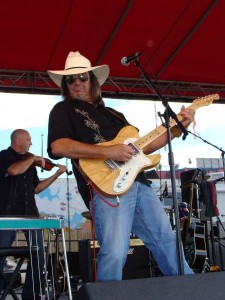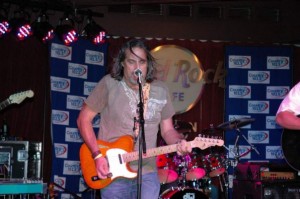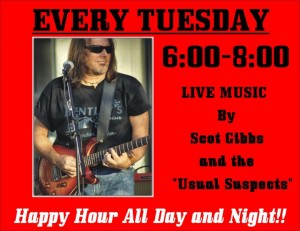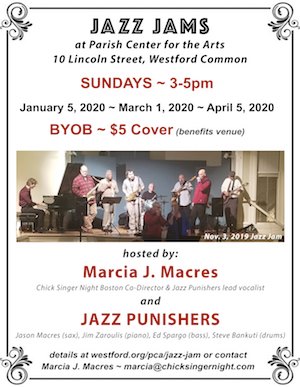 Scot Gibbs has always been a Telecaster man. Though he has always owned and continues to own many brands of guitars, the Telecaster is his thing. The guitarist from the Manchester, New Hampshire area knows what sounds best to his ears. After all, he’s been playing out professionally since the 1960s and has had much contact with national stars.
Scot Gibbs has always been a Telecaster man. Though he has always owned and continues to own many brands of guitars, the Telecaster is his thing. The guitarist from the Manchester, New Hampshire area knows what sounds best to his ears. After all, he’s been playing out professionally since the 1960s and has had much contact with national stars.
Gibbs begins his signal chain with his Telecaster. He owns four of them, all workingman like guitars. Telecaster was the first guitar that Leo Fender designed back in the 1950s. Gibbs is among the guitar fans who feel it is the best Fender design, better than the popular Stratocaster that Fender designed later on.
Many artists, Gibbs said, prefer the Telecaster. “Springsteen plays one. They have a lot of applications across genres. I think people think of it as a country guitar. More country players use Telecasters. They have the reputation of being a twangy guitar. Brad Paisley plays a version of the Telecaster.”
Gibbs likes the simplicity of the Telecaster. “It’s like a canoe paddle with electronics on it,” he said. “It’s an assembly line built guitar with very simple controls. It gives you a broad pallet of what you can do sound-wise.”
Gibbs also referred to the little known fact that most of Jimmy’s Page’s guitar parts on the first two Led Zeppelin albums were recorded with a Telecaster. “Jimmy Page is more often thought of as a Les Paul player, but he is actually a Telecaster player as well,” Gibbs said. “He had a really ugly one with a flower power decal on it that he played when they were known as The New Yardbirds.”
Gibbs bought his first guitar, a Gibson SG at Ted Herbert’s in Manchester, New Hampshire back in the day. “I still have it. It was a 1966 Gibson SG,” he said. Fender and Gibson, Gibbs explained, are very different but are the two main branches of guitar product development. The big three are Fender Telecasters and Stratocasters and Gibson Les Paul. There are subset guitars like Gibson’s SG which is used by Angus Young from AC/DC and Derek Trucks from The Allman Brothers.
“Tonally, the difference between the two: Fenders tend to be a little brighter, twangier, stingier sounding. The Gibsons are warmer, smoother, darker sounding guitars,” Gibbs said. “I use different guitars depending on the project that I’m in. My working guitars for most the bands I play with, I use one Telecaster or another.
Gibbs’ Telecaster goes directly into a pedal board. Using a cooking metaphor, Gibbs said “The pedals are like seasoning.”
Gibbs referred to The Jimi Hendrix song “Axis Bold As Love” as an example of a phaser sound. Gibbs also mentioned the Chorus(pedal) which was very popular in the 1980s. A lot of guitar players don’t care for that chorus effect nowadays. Echo, the guitarist said, was like a rockabilly favorite, like the Elvis Presley recordings that use slap back echo. Inspired by those sound effects, Gibbs assembled his own rig of pedals over the years.
His signal chain is this, in order; (occasionally, with rock or blues bands ) Vox wah. (always) Boss TU-2 tuner, Keeley Modified Ibanez TS- 9 Tube Screamer, Boss GE-7 Equalizer, Rockron Short-Timer Slapback Delay
“It’s very simple,” Gibbs said. “I use a Boss tuner TU-2 into a Keeley modified Tube Screamer and Boss Graphic EQ pedal, a Rockton Short Timer echo. I occasionally use an antique Vox wah-wah for certain projects but that’s the basics of my pedal rig. I use a Texas Red; it’s special edition Fender amplifier. It’s essentially a Blues Junior but it has some special tweaks to it. It has a Hammond reverb tank, a Celestion speaker.”
“I have those basic pieces in my rig. I actually have one group that I play with that I go directly from those three pedals into the PA. It’s pretty difficult to get a good sound that way, but that’s how they want it done in that project,” he related.
 Gibbs doesn’t dig that he leaves out half the tone chain for that band. The amplifier, he said, is basically another instrument. “Most guitar players know how to manipulate a guitar to get the sounds they want out of the guitar,” Gibbs began. “I think the real mastery of the whole genre is how you combine the guitar, the pedals, and the amplifier. So, if you’re playing without an amplifier it’s like being in a knife fight with one hand behind your back.”
Gibbs doesn’t dig that he leaves out half the tone chain for that band. The amplifier, he said, is basically another instrument. “Most guitar players know how to manipulate a guitar to get the sounds they want out of the guitar,” Gibbs began. “I think the real mastery of the whole genre is how you combine the guitar, the pedals, and the amplifier. So, if you’re playing without an amplifier it’s like being in a knife fight with one hand behind your back.”
Gibb’s first pedal is a Tuner, an electronic digital tuner which reads the vibrations of the strings and tells him how to make an adjustment with a series of L.E.D.s. “It’s a great invention,” Gibbs said. “Back in the 60s, they didn’t have those. I remember going to a lot of rock and roll shows, even fairly big bands, where the tuning was pretty sketchy. That was pretty much eliminated in the digital age.”
Gibbs’s next pedal is his Tube Screamer, popularized by Stevie Ray Vaughn. Most players, he said, has one. Gibbs uses one called TS-9. His own version had been modified by Keeley Electronics.
“That’s the only pedal that’s been consistent in all of my pedal boards for the last 15 years,” he said. “I have three of them under the bed that I stomped to death and are now broken. They call them stomp boxes, and they died a horrible death from just being used so much.” That kind of pedal gives a distorted sound, gritty.’
Usually, his signal will next go into a Graphic EQ, similar to what you find on a stereo. It compensates for different frequency ranges to make the guitars have a better output.
“I usually boost the mid range frequencies on Telecasters,” Gibbs said. “Not everybody does that. If you’re playing a heavy metal guitar, what happens a lot is, you scoop the mids. You drop them out all together so you have emphasis on the lows and the highs because the guitars you typically use for heavy metal have a lot of emphasis in the mid range and the amplifiers do too. Mid range is what gives it that heavy, gritty sound.”
From there, Gibbs sends his signal into a really cheap echo unit. It is called Flat Back, a real short repeat on the delay which thickens the sound and gives it a little bit of depth so it doesn’t sound dry. “If you know the song ’Kiss’ by Prince. That guitar has no reverb, no echo, no nothing on it. It’s very in your face,” Gibbs said. “That’s perfectly appropriate, applicable for that tune. But almost everybody else uses a little bit of delay. It’s more typically called delay or echo, to give the sound a little more dimension, a little more depth. Jimmy Page’s sound depended a lot on echo. He used an old echo unit called an Echoplex, which was a tape unit. It had a real characteristic sound.”
 Gibbs referred to Jimi Hendrix who used his pedals frequently. Hendrix had a designer named Roger Mayer who had made pedals specifically for Hendrix‘s special needs. Since the days of Hendrix, the innovations have trickled down to working musicians.
Gibbs referred to Jimi Hendrix who used his pedals frequently. Hendrix had a designer named Roger Mayer who had made pedals specifically for Hendrix‘s special needs. Since the days of Hendrix, the innovations have trickled down to working musicians.
“Now, you can get boutique pedals,” Gibbs said. “There’s literally hundred if not thousands of pedals out there,” he said. “They’re all working within a fairly narrow range. You have one that distorts the signal like the Tube Screener, ones that are time-based or time delayed, ones that are like a chorus phaser echo unit. Beyond that it goes nuts.”
How much equipment to use depends on the guitarist, Gibbs said. He recently played a gig in which one player could emulate every possible sound with a digital menu. A second guitarist only had a stomp box. Yet, he said the very best players do not use a lot of stuff.
“Jeff Beck, for instance, uses very few pedals. He uses a distortion, a wah,” Gibbs said. “At one point he used a phase shifter. But basically he gets the sound the manly way, fair means, just him and the guitar, which makes him even more amazing.”
After the signal runs through the pedals, it goes into the amp. After many years of playing, Gibbs said the amp is as much an instrument as the guitar. For rock and roll, he said, there are two main amps, Fender and Marshall. “There’s a whole science of matching the right guitar to the right amplifier,” Gibbs said. “Generally, I use Fender to Fender because I’m going for a pretty clean sound.” Others, he said, may prefer to run a Gibson into a Marshal. It depends on the genre of music and the tone a musician seeks.
After the pedals Gibbs sends his signal into his amp. He uses an old Marshall combo amp for rock and blues projects. He also has a Fender Texas Red that he prefers for his country music project. Lately, Gibbs has been using an old Gretch guitar for a project called Napoleon In Rags, a Bob Dylan inspired band that features Dylan songs and many others from that time period. His Gretch has a fat, woody sound.
Although Gibbs has several guitars and amps to choose from, his two most constants are the Telecaster and the Texas Red. After years of playing out, Gibbs prefers his simple rig. “The less stuff there is, the less there is to go wrong,” he quipped. “I have a hundred pedals but very few, after trial and error, proved to be useful. After a while, you’re getting too much coating on the song.”
Scot Gibbs is available on Facebook.

